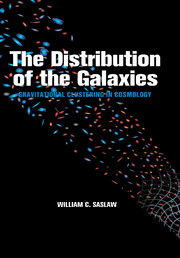Book contents
- Frontmatter
- Contents
- Prologue
- Part I Historical
- Part II Descriptions of Clustering
- Part III Gravity and Correlation Functions
- Part IV Gravity and Distribution Functions
- 21 General Properties of Distribution Functions
- 22 Dynamics of Distribution Functions
- 23 Short Review of Basic Thermodynamics
- 24 Thermodynamics and Gravity
- 25 Thermodynamic Formulation of the Cosmological Many-Body Problem
- 26 The Functional Form of b(n̄, T)
- 27 Derivation of the Spatial Distribution Function
- 28 Properties of the Spatial Gravitational Quasi-Equillibrium Distribution
- 29 The Velocity Distribution Function
- 30 Evolution of the GQED
- Part V Computer Experiments for Distribution Functions
- Part VI Observations of Distribution Functions
- Part VII Future Unfoldings
- Bibliography
- Index
29 - The Velocity Distribution Function
Published online by Cambridge University Press: 19 January 2010
- Frontmatter
- Contents
- Prologue
- Part I Historical
- Part II Descriptions of Clustering
- Part III Gravity and Correlation Functions
- Part IV Gravity and Distribution Functions
- 21 General Properties of Distribution Functions
- 22 Dynamics of Distribution Functions
- 23 Short Review of Basic Thermodynamics
- 24 Thermodynamics and Gravity
- 25 Thermodynamic Formulation of the Cosmological Many-Body Problem
- 26 The Functional Form of b(n̄, T)
- 27 Derivation of the Spatial Distribution Function
- 28 Properties of the Spatial Gravitational Quasi-Equillibrium Distribution
- 29 The Velocity Distribution Function
- 30 Evolution of the GQED
- Part V Computer Experiments for Distribution Functions
- Part VI Observations of Distribution Functions
- Part VII Future Unfoldings
- Bibliography
- Index
Summary
To and fro they were hurried about!
And to and fro, and in and out,
The wan stars danced between.
ColeridgeSpatial distribution functions, for all their usefulness, describe only half the phase space. Velocities are the other half. In the cosmological many-body problem, with galaxies interacting just through their mutual gravity, these velocities must be consistent with the galaxies' positions. On nonlinear scales where dissipation prevails, only weak memories of initial conditions or spatial coherence remain.
One measure of galaxy velocities, much studied in the 1980s (see Peebles, 1993 for a detailed summary), is the relative velocity dispersion of galaxy pairs as a function of their projected separation on the sky. For small separations this has an approximately exponential distribution. Simple dynamical models, including projection effects, can relate this pairwise distribution to the galaxy two-point correlation function in redshift space. Today, with increasing ability to measure redshifts and better secondary distance indicators, more accurate radial peculiar velocities are becoming available. So, with an eye to the future, this chapter considers the three-dimensional and radial peculiar velocity distributions predicted for the cosmological many-body problem. In Chapters 32 and 34, we will see that these predictions agree well with relevant N-body experiments and with the first observational determinations.
The peculiar velocity distribution function f(v) dv is just the probability for finding a galaxy in the system with a peculiar velocity between v and v + dv (relative to the Hubble expansion).
- Type
- Chapter
- Information
- The Distribution of the GalaxiesGravitational Clustering in Cosmology, pp. 366 - 371Publisher: Cambridge University PressPrint publication year: 1999

